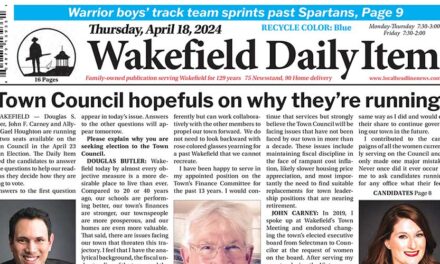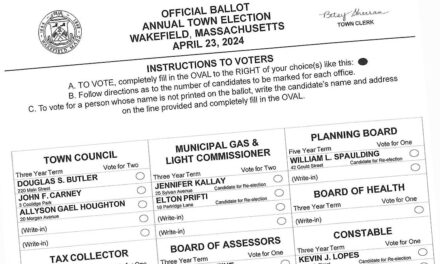Published October 28, 2020
WAKEFIELD — In addition to voting for president, United States Senator, Representative in Congress, State Senator and State Representative, Massachusetts voters casting ballots in the Nov. 3 election face two ballot questions.
Under ballot Question 2, voters will weigh in on a voting system known as “ranked choice voting,” in which voters rank one or more candidates by order of preference. Ranked choice voting would be used in primary and general elections for all Massachusetts statewide offices, state legislative offices, federal congressional offices and certain other offices beginning in 2022.
Ranked choice voting would not be used in elections for president, county commissioner or regional district school committee member.
Under the proposed law, votes would be counted in a series of rounds. In the first round, if one candidate received more than 50 percent of the first-place votes, that candidate would be declared the winner and no other rounds would be necessary. If no candidate received more than 50 percent of the first-place votes, then the candidate or candidates who received the fewest first-place votes would be eliminated and, in the next round, each vote for an eliminated candidate would instead be counted toward the next highest-ranked candidate on that voter’s ballot.
Depending on the number of candidates, additional rounds of counting could occur, with the last-place candidate or candidates in each round being eliminated and the votes for an eliminated candidate going to the voter’s next choice out of the remaining candidates. A tie for last place in any round would be broken by comparing the tied candidates’ support in earlier rounds. Ultimately, the candidate who was, out of the remaining candidates, the preference of a majority of voters would be declared the winner.
Ranked choice voting would be used only in races where a single candidate is to be declared the winner and not in races where more than one person is to be elected.
Under the proposed law, if no candidate received more than 50 percent of first-place votes in the first round, the rounds of ballot-counting necessary for ranked-choice voting would be conducted at a central tabulation facility. At the facility, voters’ rankings would be entered into a computer, which would then be used to calculate the results of each round of the counting process.
The proposed law provides that candidates in a statewide or district election would have at least three days to request a recount. The Secretary of State would be required to issue regulations to implement the proposed law and conduct a voter education campaign about the ranked-choice voting process. The proposed law would take effect on January 1, 2022.
Those in favor of Question 2 say that ranked choice voting is “a common-sense reform that puts more power in the hands of voters. Proponents stated that ranked choice voting addresses three problems:
1. Big money and corrupt special interests have too much control over our democracy.
2. Politicians can win with less than a majority, and independents are shut out.
3. Politics are tearing us apart, preventing solutions to major challenges It works by giving voters the option to rank candidates in order of preference.
You can vote for just one candidate like you always have, or you can rank your first, second and third choice.
Under ranked choice voting, if your favorite candidate doesn’t win, your vote is instantly counted for your second choice so candidates must compete for every vote. Advocates claim that ranked choice voting ensures the winner has majority support and reflects the true will of the people. They argue that a “yes” vote on Question 2 gives voters more voice and will help make our democracy stronger.”
Those urging a “no” vote on Question 2 point out that two Democratic governors rejected ranked choice voting because it was confusing and denied voters informed choice. Former California Gov. Jerry Brown, a Democrat, witnessed a mayoral election in Oakland where the winner won with voters’ seventh and eighth place rankings. Brown said, “Ranked choice voting is overly complicated and confusing. I believe it deprives voters of genuinely informed choice.”
Democratic Governor Gavin Newsom said ranked choice voting “has often led to voter confusion and the promise that ranked choice voting leads to greater democracy is not necessarily fulfilled.”
According to the opponents of Question 2, ranked choice voting ballots force voters to guess the candidates who will remain standing in multiple voting rounds and cast their votes in the dark. If they guess wrong and vote for eliminated candidates, their ballots are not counted in the final vote. Winners win a false “majority” of remaining ballots, not a true majority of all the voters voting in the election.




